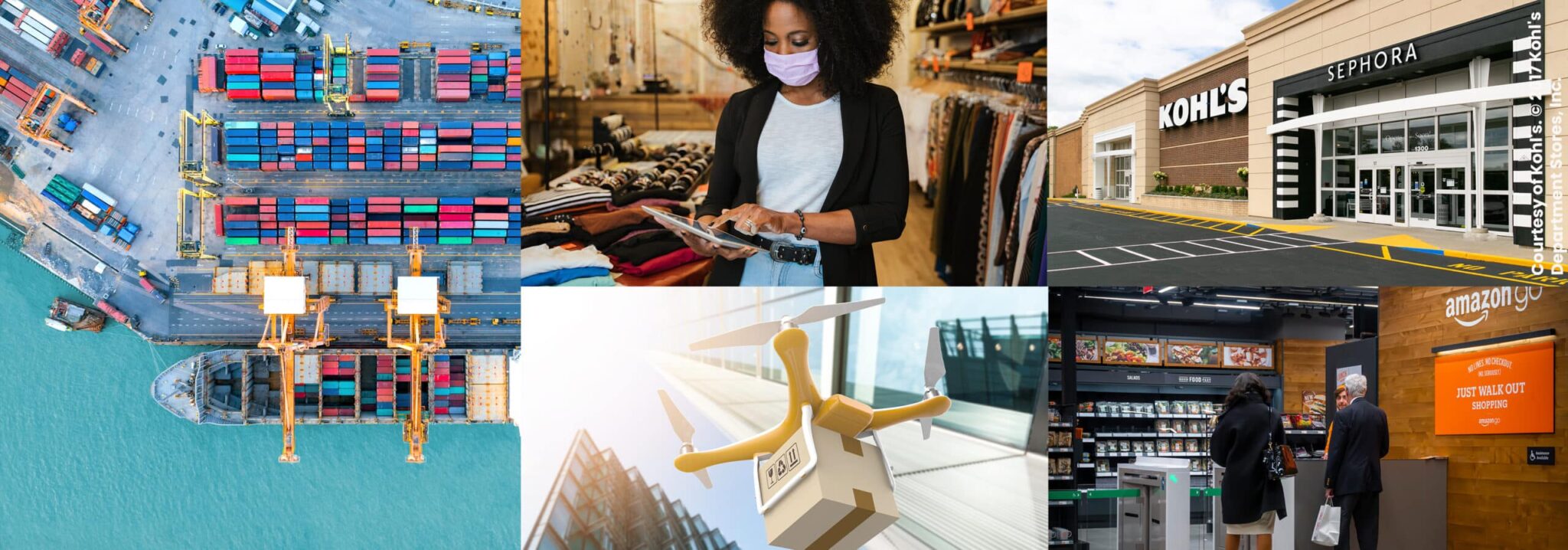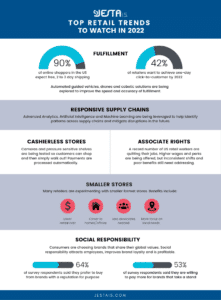by Camille Chin | February 1, 2022
The retail industry has never changed faster than it did in 2020 and 2021. Agility became a keyword as many retail businesses rushed to respond to new consumer demands for safer ways to shop. Alongside online shopping, buy online pickup in store (BOPIS), buy online pickup at curbside (BOPAC) and contactless payment for safety and convenience, consumers continued to expect speed.
McKinsey research reveals that 90 percent of online shoppers in the US expect free, two- to three-day shipping, and when delivery times are too long, almost half of omnichannel shoppers will bring their business elsewhere. Retailers know that speed matters: 42 percent of apparel, hard goods and specialty retailers are aiming to achieve one-day click-to-customer by 2022.
The need for speed will be an ongoing goal for retail businesses this year, but many have their sights set on more. Here are five retail trends that we think will shape the industry over the next 12 months.
1. The three A’s of the Supply Chain
Analytics, artificial intelligence (AI) and automation will be key to planning, manufacturing, warehousing, logistics and fulfillment in 2022. Advanced analytics, AI and machine learning (ML) can better leverage data to identify patterns across supply chains. By analyzing if and how patterns are related to external factors such as weather, traffic and even staff shift changes, analytics, AI and ML can help mitigate the impact of supply chain disruptions in the future.
As businesses grow their fulfillment networks to include physical stores, dark stores and urban fulfillment centres as additional points of distribution, inventory management will become more complex. Bespoke analytics will provide invaluable insights to guide new inventory strategies.
Automation will streamline many steps in the supply chain particularly in distribution centres (DCs). Automated guided vehicles (AGVs), drones and co-botic solutions (robots that collaborate with humans) are improving the speed and accuracy of order fulfillment. Robotics as a service (RaaS) eliminates the need for a big initial investment and enables scalability.
2. Cashierless Stores and Driverless Vehicles
Last-mile delivery is the most expensive leg of the shipping journey. It’s also the most time consuming, which greatly impacts customer experience. Retailers are eager to improve the last stretch of fulfillment, and are exploring autonomous delivery services to save time and money.
Amazon Prime Air and UPS Flight Forward have been experimenting with drones, while some companies in the food industry such as Domino’s are testing out self-driving delivery vehicles. Walmart has a partnership with Ford Motor and Argo AI as well as GM and Gatik that allows customers to place orders of groceries for autonomous delivery in some US cities.
Amazon Go and Fresh stores are leading the cashierless-store transformation. Customers scan an Amazon app to enter the stores, and cameras and pressure sensitive shelves automatically track their movements and selected items. Once customers are done shopping, they can simply walk out of the store. Payment is processed automatically.
Despite reports that Amazon’s Just Walk Out technology is expensive to implement and maintain, Amazon has sold it to other retailers. Kroger, Walmart and 7-Eleven are exploring cashierless technology as well. It’s debatable whether the technology is suitable for retail verticals beyond grocery and convenience.
3. Stores – Small and Virtual
Another retail trend to watch: many retailers are experimenting with smaller format stores. Bloomingdale’s recently opened Bloomie’s; Macy’s has five Market by Macy’s locations; Sephora at Kohl’s opened 200 locations in 2021 and 850 are planned by the end of 2023. Sephora at Kohl’s is a store within a store occupying 2500 square feet near the entrance. Best Buy and Ikea are testing smaller stores too.
A smaller store has a lower rental cost, which gives retailers the ability to open multiple stores in different and more accessible locations. One central, big box store is often further from homes and offices. Smaller stores also require fewer sales associates, which were hard to come by in 2021. The ability to customize inventory and services to local needs for better store experiences is another big benefit.
Other retailers are foregoing the physical for the futuristic and experimenting with virtual stores. Virtual reality (VR) and augmented reality (AR) allow customers to use apps to see merchandise on them and in their homes. The Metaverse aims to take things to the next level.
The Metaverse is set to exist in the present time on an ongoing basis and will enable people to experience a parallel life to their real-world existence as a hyper-realistic 3D avatar.
Gap has already gotten in the game with the recent launch of four digital hoodies priced in blockchain currency XTZ, and it’s rumoured that Nike has begun production on virtual sneakers and apparel. Virtual furniture, electronics and toys are likely in the works; Walmart filed new trademarks in late 2021 that hint at its intent to design and sell virtual goods.
4. A Focus on the Workforce
Decades of low wages, lack of career progression, inflexible scheduling and pandemic burnout are some of the reasons that a record number of US retail workers are quitting their jobs at rates that are higher than most other industries.
“There is no question that staffing is definitely a big issue this time around,” Stephanie Martz, chief administrative officer and general counsel of the National Retail Federation, told CNBC in early January 2022. “It was maybe less measurable when we were at a point in the pandemic when so much was closed and everything was so scaled down.”
To cope with labor shortages, stores are shortening their hours and closing fitting rooms. Higher wages and perks such as signing bonuses and tuition reimbursements are being offered by some companies including Amazon, Best Buy and Target. Inconsistent shifts, poor benefits and hazard pay, and lack of childcare are important issues that labour experts suggest still need addressing. Expect even more focus on retail worker experiences in the months to come.
5. Social Responsibility – A Win-Win
Is your retail business committed to diversity, equity and inclusion? Do you source your products ethically and fairly? Is there a move towards sustainability?
Consumers expect retailers to know them and engage with them on a personal level, but today more and more consumers are choosing to support brands that share their global values. Social justice, human rights, climate change, and physical and mental wellbeing are at the forefront of all of our minds. Consumers want to build relationships with brands that use social responsibility as a way to give back and thank shoppers for their loyalty.
Instead of stickers that tout “End Racism” and “We are Green,” consumers want efforts that are genuine and impactful, and won’t hesitate to shift their loyalties if their expectations aren’t met.
Social responsibility is a win-win for companies and communities alike: it helps attract and retain employees, improves brand reputation and customer relationships, and it’s profitable. In a 2021 survey of 395,000 consumers, 64 percent of respondents said they prefer to buy from companies with a reputation for purpose as well as profit and 53 percent said they are willing to pay more for brands that take a stand.
Decisions in 2022 likely won’t be as hasty as they were in 2020 and 2021. The New Year may even allow for a brief retail reset. New challenges will undoubtedly emerge, but retailers can rest assured that they are now more adept than ever at adapting.
Check out the Retail Trends infographic here.
[jesta_exit_intent text=”Looking for future-focused technology that drives business results?” strong_text=”Talk to an expert!” image=”https://www.jestais.com/wp-content/uploads/2021/03/exit-intent-analytics.jpg” yes_link=”/contact-us?form_source=top-retail-trends-to-watch-in-2022″]

